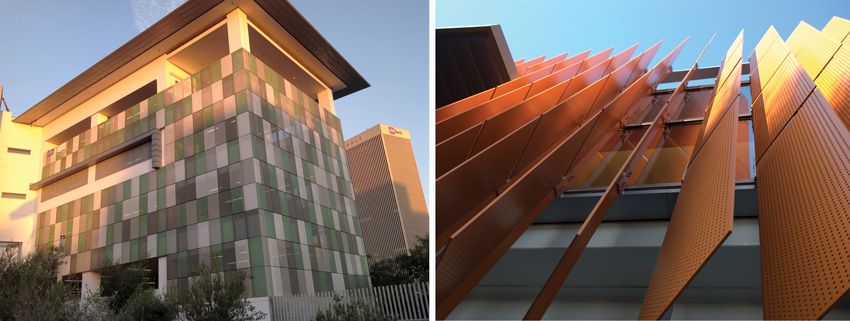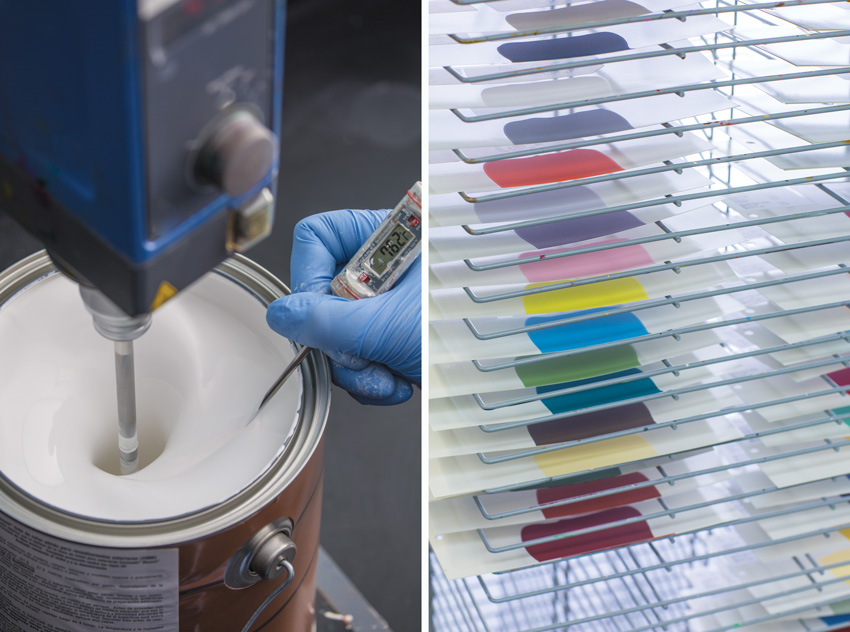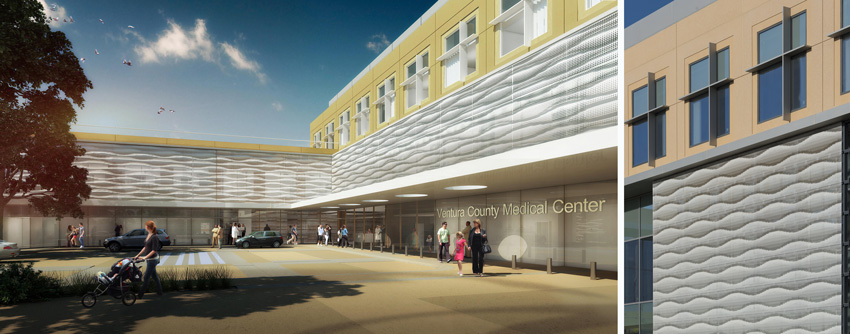Designing Green: The Seen and the Unseen
Solar Screening
While allowing light and ventilation into a building is commonly achieved with window systems of some sort, there are other considerations for green and sustainable buildings too. In cases where the amount of sunlight needs to be controlled to limit solar heat gain and control energy usage, one of the most effective methods is to add an exterior treatment, such as a sun screen or awning. The exterior treatment stops the sunlight and resulting heat gain before it ever enters the window or the building, making it one of the more effective strategies for reducing heat gain in buildings. It also provides real opportunities for the creative design of building facades and exteriors.
When looking at options for sun shade materials, one common approach is to use perforated metal. This choice has the benefit of being able to select or design the amount and style of perforation to provide differing levels of light penetration and/or reflectance. In addition to keeping the building cooler in the sunlight, perforated metal can also allow controlled light and views either directly through perforations in the sunscreen or between vertical louvers or baffles. There are also any number of other creative design options for daylight and views with this material based on the needs of the building and the overall design intent.
Beyond daylight, perforated sunscreens allow air to pass through them. For building occupants, that means they can still open windows or operate ventilation systems and receive plenty of fresh air. For exterior structural design, it means that wind loading is dissipated compared to an all solid material. Both of these conditions make it easy to add perforated metal sun screens to most building types.
Of course, any material used in a green building needs to be looked at in terms of its overall attributes. Perforated metal sun screens can be specified to be made from a high recycled post- and pre-consumer content to avoid the use of virgin raw materials. On-site, the sun screens can be sized and manufactured to reduce or eliminate waste. Further, at the end of its service life, 100 percent of perforated metal can be recycled. The finishing of the metal can also be a concern, particularly if volatile organic compounds (VOCs) are involved with the finishing. Hence, it is possible to use low-VOC finishes, or for certain metals and in some building designs, no finish may be required, thus eliminating the concern altogether.
From a building use perspective, perforated metal is an economical and very durable option. It typically requires very little maintenance compared to other materials since it needs less refinishing and less cleaning over time. It is quite common for it to hold up for decades, not just years. On and within the building, perforated metal can support biophilic design, which is one of the Imperatives (number 09) of the Living Building Challenge. Under this requirement, the intent is to foster and nurture the connection between people and nature in the form of light, air, and environmental features as well as the use of natural shapes and forms. The perforated metal can be shaped and formed specifically to provide light and ventilation where it is needed but also to mimic shapes and forms from nature.
Overall, the use of perforated metal sun screens is another example of a single product or design solution that can address multiple aspects of green and sustainable design in a balanced way. As such, they can contribute to points and credits for green building certification programs, such as LEED, WELL, and LBC.

Photos courtesy of Accurate Perforating (left) and Accurate Perforating/Jonathon Lachlan-Hache (right)
Perforated metal sunscreens can be used on building facades in a variety of ways to help control energy use while still providing light and ventilation as well as biophilic design possibilities.
Paints and Finishes for Responsible Interiors
LEED, WELL, the LBC and other programs are specifically concerned with the impacts of the interior environment on human health. In particular, they focus on the products and materials used inside a building and their specific chemical makeup. It is easy to understand that in a closed, indoor environment, people may react poorly when regularly exposed to products that emit certain chemicals or compounds, even if the quantities are small. Hence, there has been a considerable focus to require manufacturers to declare what is in the materials or products that they create, just as food products need to list the ingredients in them for health reasons. This allows designers, specifiers, and consumers to make informed choices and compare different products for use or exclusion in buildings.
A good example of where this responsible interior concept applies is the use of paints and finishes that are formulated out of a variety of chemical compounds and elements and which can be quite ubiquitous inside buildings. Recognizing this, they are often scrutinized particularly for the amount of volatile organic compounds (VOCs) and other ingredients. In particular, under LEED v4, flat paint must meet a VOC level of 50 grams per liter (g/L) or less, while non-flat paint is allowed 100 g/L or less, as well as be emissions certified. This is a restrictive but increasingly achievable requirement as paint manufacturers work to reduce or even eliminate VOCs from their formulations.
In addition to this basic requirement, LEED v4 awards credits where an environmental product declaration (EPD) is provided as a way of communicating the results of a detailed life-cycle assessment (LCA) of the ingredients and processes involved in a product. The American Coatings Association and the U.S. coatings industry have developed a standardized format for measuring the environmental impacts of architectural paint based on a defined set of criteria. Individual manufacturers are using this format to conduct an LCA and ultimately an EPD that would allow certain brands to qualify for the appropriate LEED credits. A similar process can create a health product declaration (HPD), which discloses the chemical profile of a product, including both hazardous and nonhazardous ingredients, in more detail. LEED recognizes both the EPD and HPD as a means to demonstrate qualification for certain credits/points.
Beyond LEED, the WELL program similarly seeks to reduce VOCs and achieve transparency in product makeup. WELL Feature 04 specifically focuses on VOC reduction, while Features 11, 26, and 97 address fundamental and enhanced material safety and transparency. Some of these requirements are aligned or equivalent between the LEED and WELL standard, while others only overlap partially. Therefore, when seeking to obtain certification in either standard, it is important to review the specific language and details of what is being assessed for human health impact. Note that when reviewing the information, both the paint base and the colorants are important since adding colorant to a low-VOC paint can increase levels significantly. Some colorants alone can meet or exceed the 100 g/L threshold separate from the paint base, while other manufacturers have produced zero-VOC colorants (according to EPA Method 24): Determination of Volatile Matter Content, Water Content, Density, Volume Solids, and Weight Solids of Surface Coatings. Further, if a full life cycle (or duty cycle) of the paint or coating is being considered, then the anticipated number of repaintings will influence the total VOC emissions over time.

Photos courtesy of Benjamin Moore
When assessing interior finishes, both base paints and colorants used in them need to be considered for chemical ingredient content, including VOCs or Red List items.
The Living Building Challenge takes a slightly different approach to interior health and materials used in construction. Rather than trying to identify acceptable levels of certain chemicals or compounds, they simply call for them to be eliminated completely from buildings that seek certification. Specifically, they have researched and identified a “Red List” of chemicals and compounds that are known to pose serious risks to human health and the environment. Under required imperative 10, a project must be free of anything on the Red List. The means to identify this and other imperatives comes from third-party verified information on manufactured products under the Declare program of the LBC and covered in imperative 12. This initiative focuses on product ingredients and uses an intentionally simple, color-coded summary label that declares any potential hazards. The choices for each ingredient listed can be a warning that something is 1) on the Red List; 2) another chemical of concern identified by the U.S. Environmental Protection Agency; or 3) not a hazardous chemical.
Designers and specifiers can request Declare labels directly from manufacturers and can use this information to specify materials that are free of Red List ingredients or other chemicals of concern. The International Living Future Institute, which administers the Living Building Challenge, also keeps a list of products and materials on its website that have filed declare labels (https://living-future.org/declare/). A search can be initiated by manufacturer name, by CSI Specification Division, or by geographic location in the world. Given the extensive list of products and materials, a helpful tab for “status” also provides sorted lists based on either Red List free, LBC compliant, declared, third-party verified, or LEED v4 listed.
It is worth noting that some paints and finishes can also be Cradle to Cradle Certified™. This product standard guides designers and manufacturers through a continual improvement process based on five categories: material health, material reutilization, renewable energy and carbon management, water stewardship, and social fairness. A product can receive an achievement level in each category, with the lowest representing the product’s overall mark. Product assessments are performed by a qualified independent organization trained by the Cradle to Cradle Product Innovation Institute, a nonprofit organization that manages the certification program. Every two years, manufacturers must demonstrate good faith efforts to improve their products in order to have their products recertified. Some paints meet this ongoing recertification, and evidence of the same can be requested from the manufacturers or the Cradle to Cradle Product Innovation Institute (www.c2ccertified.org/).
Notice

www.accurateperforating.com

www.archgrille.com

www.benjaminmoore.com/scuff-x

www.extechinc.com/techvent

ZIPSystem.com/R-sheathing










